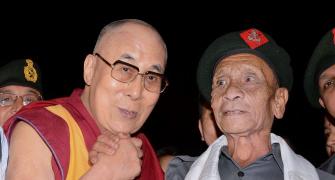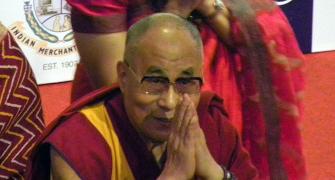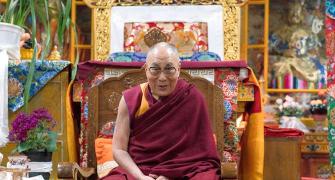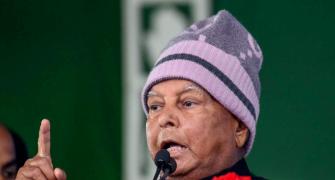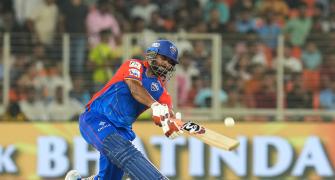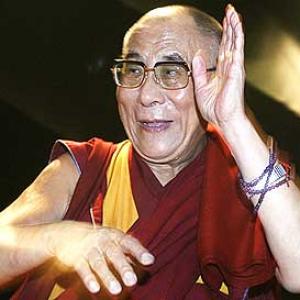Count among The Light of Asia's many, many admirers over 132 years: Gandhi, Tagore, Vivekananda, Nehru and Ambedkar, Tolstoy and Kipling, Yeats and Eliot, Alfred Nobel, Dmitri Mendeleev and C V Raman.
Jairam Ramesh reveals why he decided to write a book on Edwin Arnold, who wrote The Light of Asia.
Illustrations: Dominic Xavier/Rediff.com

On its release in July 1879, it immediately took England by storm, and soon thereafter America and Europe too were stirred by it. The epidemic of exuberance for it would spread to other parts of the world and last a few decades.
The book captivated an Indian monk who remains an iconic personality -- Swami Vivekananda. At about the same time, it deeply moved a young man in Colombo who has become famous in history as Anagarika Dharmapala. It caught the attention of an aspiring Indian lawyer in London in 1889. This man later became immortal as Mahatma Gandhi.
A few years hence it impacted a teenager in Allahabad who would, in 1947, become the first prime minister of India -- Jawaharlal Nehru.
Two copies of the book adorned the bookshelves of B R Ambedkar, the prime architect of the Indian Constitution. It informed the work of men who were active in the movement for social justice, especially in south India in the early part of the twentieth century.
The book had a marked influence on at least eleven literary personalities from across the world.
Five of them were Nobel Laureates: Rudyard Kipling in 1907, Rabindranath Tagore in 1913, W B Yeats in 1923, Ivan Bunin in 1933 and T S Eliot in 1948.
The other six are legendary figures: Herman Melville, Leo Tolstoy, Lafcadio Hearn, D H Lawrence, John Masefield and Jose Luis Borges.
The world of science and industry was not immune to its reach either. At the turn of the nineteenth century, it shaped the life of a young science student in Madras who would, in 1930, become India's first Nobel Laureate in Physics -- C V Raman.
The Russian chemist and inventor of the periodic table Dmitri Mendeleev and the Scottish-American industrialist-philanthropist Andrew Carnegie had a special affinity to it.
An extremely controversial figure of the British military but a hero during his time -- Herbert Kitchener -- would carry this book along with him wherever he went.
It figures prominently in the private library of Alfred Nobel, the Swedish businessman who later endowed the Nobel Prizes.
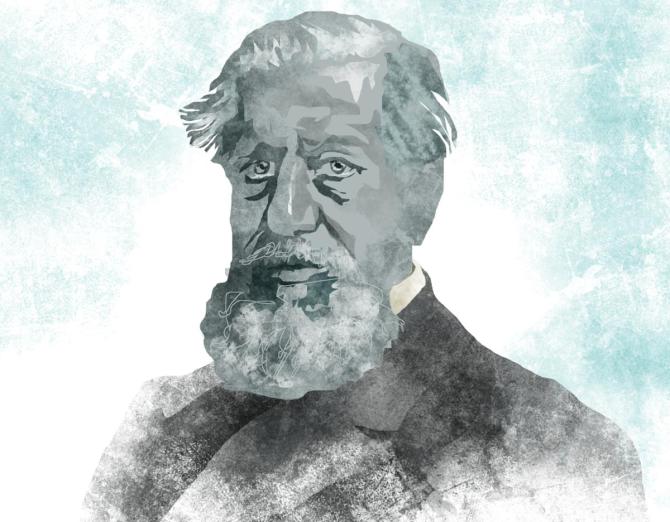
In 1925, it was to serve as the basis for one of India's first silent films, made by a German-Indian team. This was released internationally to some acclaim.
In 1945 it figured in a Hollywood classic, The Picture of Dorian Gray. In 1957, a very ill Raymond Chandler, the British-American detective storywriter, received a letter from his long-time secretary advising him to take solace in reading this book.
The book is The Light of Asia, a narrative of the life and message of the Buddha.
Sir Edwin Arnold is its author. Its publication was a milestone in the nineteenth century rediscovery of the Buddha.
I first read The Light of Asia in my mid-teens. It has remained with me for over half a century. Two recent events rekindled my memories of the poem and its author.
First, while going through the correspondence of Jawaharlal Nehru, I discovered a letter to him dated 21 February 1955 from his British counterpart. Winston Churchill wrote:
I hope you will think of the phrase 'The Light of Asia'. It seems to me that you might be able to do what no other human being could in giving India the lead, at least in the realm of thought, throughout Asia, with the freedom and dignity of the individual as the ideal rather than the Communist Party drill book. (italics mine)
Churchill was writing to a man imprisoned by the British in nine different spells between 1921 and 1945 for a total of almost ten years.
The longest period Nehru spent in jail was between August 1942 and June 1945 when Churchill was prime minister.
That is what makes this letter quite remarkable. But this was not all. Four months later, on 30 June 1955, Churchill again to wrote to Nehru:
I hope you will forgive the lapse of time in replying to your letter of April 8. Events following upon my resignation, and the General Election here, have delayed my correspondence greatly.
I was much touched by what you said. One of the most agreeable memories of my last years in office is our association. At our conferences [of Commonwealth Premiers] your contribution was a leading and constructive one, and I always admired your ardent wish for peace and the absence of bitterness in your consideration of the antagonisms that had in the past divided us.
Yours is indeed a heavy burden and responsibility, shaping the destiny of your many millions of countrymen and playing your outstanding part in world affairs. I wish you well in your task.
Remember 'The Light of Asia!' (italics mine)
Only two bibliophilic prime ministers could have had a correspondence in the last decade of their lives recalling a book both had read when they were young.
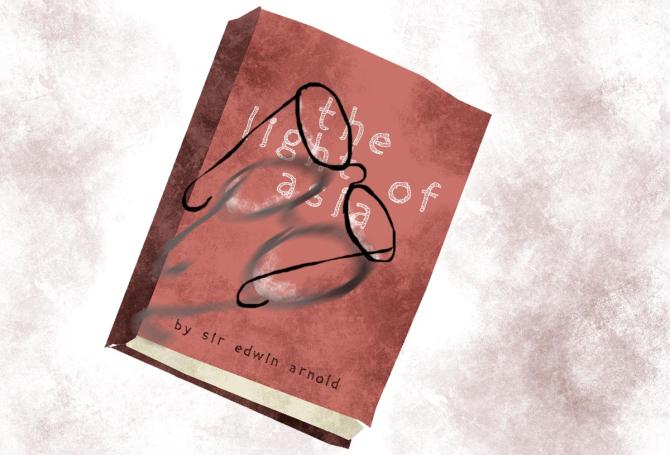
In fact, when Nehru was undergoing the second round of his imprisonment by the British in Lucknow jail, he wrote to his father on 13 July 1922:
I have received your kind letter ... You need not worry at all about my health. I am looking after it carefully ... I have received the books sent by you. I have now got the following:
1. Memoirs of Babar
2. Sarkar's Shivaji
3. Bernier's Travels
4. Vincent Smith's Akbar
5. Manucci's Storia do Mogor -- 4 vols
6. Bryce's Holy Roman Empire
7. Poems of Keats
8. Poems of Shelley
9. Tennyson's Idylls of the King
10. Arnold's Light of Asia
11. Havell's Aryan Rule in India (this came separately)
12. Pater's Renaissance (received yesterday)
And when his daughter was convalescing from pleurisy in Leysin in Switzerland, Nehru would on 22 February 1940 send 'Arnold's two little books: The Light of Asia and The Song Celestial' to keep her company.
Second, contemporary Indian politics has been impacted hugely by the dispute over the birthplace of Lord Rama the mythological hero of the epic Ramayana.
For over four and a half centuries, a mosque stood at the site purported to be his birthplace in the town of Ayodhya.
That mosque was demolished by rampaging mobs on 6 December 1992. After a protracted legal battle, Hindu organisations got possession of the site in November 2019. A temple is now under construction there.
Between 1886 and 1953, there was a somewhat similar dispute over the ownership of a temple at Bodh Gaya where Siddhartha Gautama received enlightenment and became the Buddha.
With his visit to this holy site in 1886, Sir Edwin Arnold lit the spark for a long battle between a Hindu sect that had been in control of the temple since the seventeenth century and the Sri Lankan monk Anagarika Dharmapala, the founder of the Mahabodhi Society.
With Sir Edwin's backing, Dharmapala launched the struggle to recover Buddhist control over Bodh Gaya from Hindu ownership. The dispute was finally resolved only in 1953 -- but peacefully.

Edwin Arnold was a quintessential Victorian in every way. A remarkable polyglot, he was conversant in Greek, Latin, Arabic, Turkish, French, German, Japanese, Hebrew, Persian, Sanskrit and Marathi.
For about forty years he was a leader writer for London's newspaper the Daily Telegraph.
He was a firm believer in the civilizing mission of the British Empire, but he was also at the same time an ardent Indophile.
He spent two-and-a-half years in India between late-1857 and mid-1860 as the first principal of what became the famed Deccan College in Poona.
His views on education for the 'natives' were progressive by the standards of those times.
He returned to India and Ceylon for a hundred days in late 1885 and left a vivid account of this trip which even today makes for riveting reading.
Sir Edwin was fascinated with Hinduism, Buddhism and Islam, although he also wrote The Light of the World -- a panegyric to Jesus Christ.
His translation of the Bhagavad Gita called The Song Celestial first introduced Mahatma Gandhi to this classic who would keep referring to it in his correspondence till the end of his life.
None of Arnold's works, however, attained the fame and longevity of The Light of Asia. Gandhi and Arnold were both active in London's Vegetarian Society and the two seemed to have grown fond of each other.
But for all his many-sided accomplishments Arnold has attracted only one serious biographer so far, and that was way back in 1957.
I, therefore, set out to throw fresh light on who Sir Edwin Arnold was, how his life unfolded, how his relationship with India evolved and why he came to write The Light of Asia, which proved to be a work of such seminal importance, an enduring milestone in the world's rediscovery of an ancient philosophy and faith.
There was, to be sure, more to Edwin Arnold than his India connection. He was, for instance, an important player in Henry Morton Stanley's first Congo expedition during 1874-1876 and even had a mountain and a river named after him there.
He was the first to advocate a 'Cape to Cairo' rail link that epitomized British colonial interests in Africa.
Queen Victoria was very fond of him and had she had her way he would have become Britain's Poet Laureate in 1892 at the death of Lord Tennyson.
This edited excerpt from The Light Of Asia: The Poem That Defined The Buddha by Jairam Ramesh has been used with the kind permission of the publishers, Penguin Random House India.

